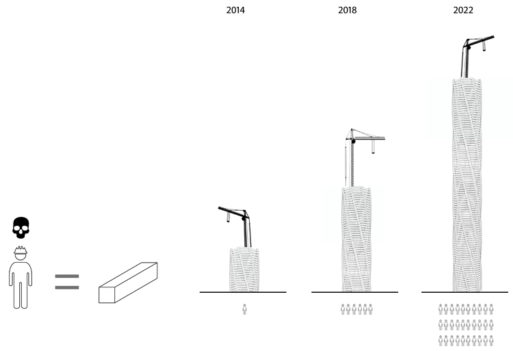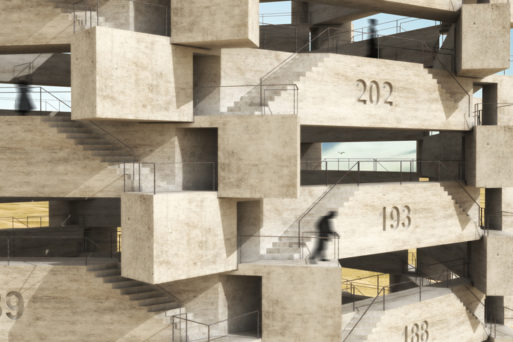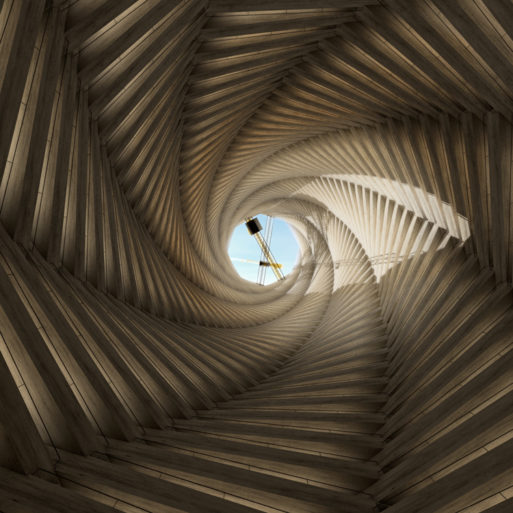
Qatar World Cup Memorial concept art
(Credit: 1week1project.org)
The proposed Qatar World Cup Memorial project was designed by French architects Axel de Stampa and Sylvain Macaux, who founded the 1Week1Project collective. 1Week1Project comprises approximately 25 designs that are primarily speculative in nature, meant to serve as social commentary.
The Qatar World Cup Memorial was inspired by a report by the Guardian, which said that over 500 Indian and 400 Nepalese migrant workers have died since construction began on various projects in and around Qatar in preparation for the 2022 World Cup. According to the Guardian, “The grim statistic comes from the Pravasi Nepali Coordination Committee, a respected human rights organisation which compiles lists of the dead using official sources in Doha. It will pile new pressure on the Qatari authorities — and on football’s world governing body, FIFA — to curb a mounting death toll that some are warning could hit 4,000 by the time the 2022 Finals take place.”

Progress(?)
(Credit: 1week1project.org)
The Qatar World Cup Memorial would be constructed in a spiralized design comprised of concrete modules continuously stacked as the death toll rises, each sectional piece numbered to reflect each life lost. Each floor of the memorial would comprise four modules and two staircases. A crane would remain positioned at altitude until construction is completed in 2022.

View from outside
(Credit: 1week1project.org)
Aside from drawing public attention to the negligence and callousness of Qatari contractors and the failure of the local government to put better safety regulations in place, this memorial concept also highlights several pertinent issues pertaining to collective memory and grief. It raises questions such as, “Which lives are worthy of commemoration?” and “Who decides?” In this sense, the Qatar World Cup Memorial pays tribute to all lives that are considered “disposable.”
One function of public memorials is to knit together the grief of individuals into a common web of understanding and experience. The most economically impoverished and those who do not enjoy a socially, financially, or racially privileged place in society are often left out of the collective story, which is written and designed by people in power. Additionally, memorials are often inspired by large-scale and highly visible events, whereas those who die from medical accidents (a taboo subject) or chronic diseases such as cancer are left to cope in isolation.

Floor view from inside
(Credit: 1week1project.org)
The ongoing nature of the Qatar World Cup Memorial could be taken to heart by individuals interested in commemorating their loved ones in a more structured and intentional way, just as all our ancestors made a place for their deceased loved ones on an altar; at a family temple; at the extra plate set on the supper table; and in their prayers. Grief that is disenfranchised (unrecognized by society for the full impact it has on those who feel it) can be given a dignified place to rest, even if that is a personal altar at home. To memorialize is to assert the value and living memory of someone who is no longer physically present. We all have the power to do this for ourselves and each other.

 Qatar World Cup Memorial Commemorates Migrant Worker Deaths
Qatar World Cup Memorial Commemorates Migrant Worker Deaths


 John Mulaney’s “Funeral Planning” on Netflix: No Real Plan
John Mulaney’s “Funeral Planning” on Netflix: No Real Plan

 Composting Bodies Is Now Legal in a Dozen States
Composting Bodies Is Now Legal in a Dozen States














